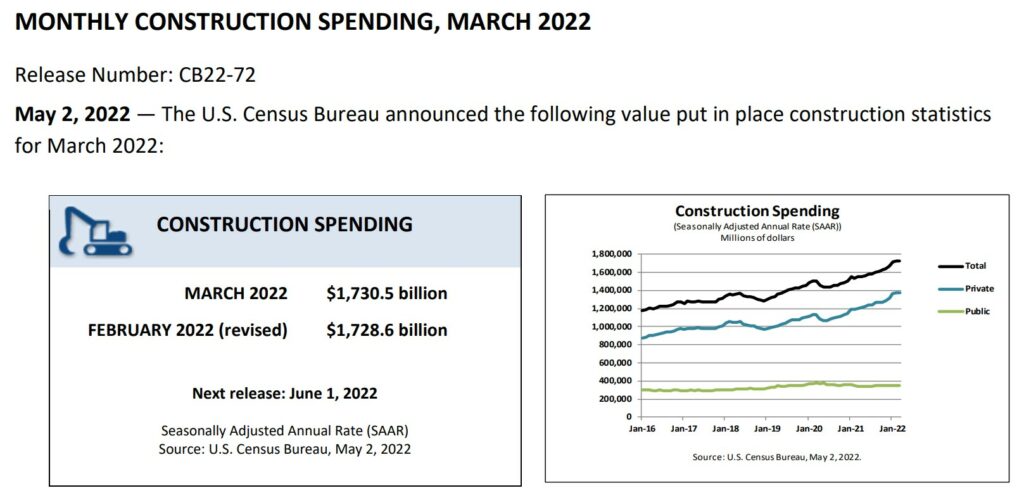RJS, MarketWatch 666 Summary: Construction Spending Rose 0.1% in March after Prior Months Were Revised Higher The Census Bureau’s report on construction spending for March (pdf) estimated that the month’s seasonally adjusted construction spending would work out to ,730.5 billion annually if extrapolated over an entire year, which was 0.1 percent (±0.7%)* above the revised annualized February estimate of ,728.6 billion, and 11.7 percent (±1.0 percent) above the estimated annualized level of construction spending in March of last year . . . Census also reports that for the first three months of this year, construction spending has totaled 6.6 billion, 12.0 percent (±1.0 percent) above the 6.3 billion spent during the same three
Topics:
Angry Bear considers the following as important: Construction March 2022, Hot Topics, MarketWatch 666, RJS, US EConomics
This could be interesting, too:
NewDealdemocrat writes JOLTS revisions from Yesterday’s Report
Joel Eissenberg writes No Invading Allies Act
Bill Haskell writes The North American Automobile Industry Waits for Trump and the Gov. to Act
Bill Haskell writes Families Struggle Paying for Child Care While Working
RJS, MarketWatch 666
Summary: Construction Spending Rose 0.1% in March after Prior Months Were Revised Higher
The Census Bureau’s report on construction spending for March (pdf) estimated that the month’s seasonally adjusted construction spending would work out to $1,730.5 billion annually if extrapolated over an entire year, which was 0.1 percent (±0.7%)* above the revised annualized February estimate of $1,728.6 billion, and 11.7 percent (±1.0 percent) above the estimated annualized level of construction spending in March of last year . . . Census also reports that for the first three months of this year, construction spending has totaled $376.6 billion, 12.0 percent (±1.0 percent) above the $336.3 billion spent during the same three months of 2021 . . . the annualized February construction spending estimate was revised 1.4% higher, from $1,704.4 billion to $1,728.6 billion, while the annual rate of construction spending for January was also revised 1.4% higher, from $1,695.5 billion to $1,719.1 billion, which left the February construction spending increase unchanged at +0.5%..
A further breakdown of the different subsets of construction spending are provided by a Census summary, which precedes the detailed spreadsheets, is included below:
- Private Construction: Spending on private construction was at a seasonally adjusted annual rate of $1,379.7 billion, 0.2 percent (±0.5 percent)* above the revised February estimate of $1,376.9 billion. Residential construction was at a seasonally adjusted annual rate of $882.0 billion in March, 1.0 percent (±1.3 percent)* above the revised February estimate of $873.2 billion. Nonresidential construction was at a seasonally adjusted annual rate of $497.6 billion in March, 1.2 percent (±0.5 percent) below the revised February estimate of $503.6 billion.
- Public Construction: In March, the estimated seasonally adjusted annual rate of public construction spending was $350.8 billion, 0.2 percent (±1.3 percent)* below the revised February estimate of $351.7 billion. Educational construction was at a seasonally adjusted annual rate of $80.3 billion, 0.8 percent (±1.6 percent)* below the revised February estimate of $81.0 billion. Highway construction was at a seasonally adjusted annual rate of $103.1 billion, 0.4 percent (±4.1 percent)* below the revised February estimate of $103.5 billion.
With the large upward revisions to January and February figures, construction spending for all three months of the 1st quarter was higher than was reported by the BEA in their advance estimate of GDP that we covered last week . . . as we saw above, annualized construction spending for January was revised $23.6 billion higher, and annualized construction spending for February was revised $24.2 billion higher . . . in reporting 1st quarter GDP, the BEA’s key source data and assumptions (xls) indicated that they had estimated March residential construction would be $10.0 billion more (at an annual rate) than that of the previously reported February figure, that March nonresidential construction would be valued $5.5 billion more than that of the reported February figure, and that March public construction would increase by $0.5 billion from previously reported February levels . . . totaling those figures, the 1st quarter GDP report showed March construction spending to be at an annual rate $16.0 billion higher than previously reported February levels…since this report shows that March construction spending was up at an $1.9 billion annual rate from February figures that were revised $24.2 billion higher, that means the total annualized construction figure used for March in the GDP report was $10.1 billion too low . . . averaging that understatement with the understatements in the annual rates of construction spending used for January and February in the GDP report, we find this report shows that construction spending was underestimated by $19.3 billion (at an annual rate) in the 1st quarter GDP report, implying an upward revision to the related GDP components at a rate that would result in a addition of about 0.28 percentage points to first quarter GDP when the 2nd estimate is released at the end of May . . . we should caution that since our estimate is based on the aggregate change in spending, an imbalance of inflation adjustments among the revised construction components might also have a material impact on the final revision..

